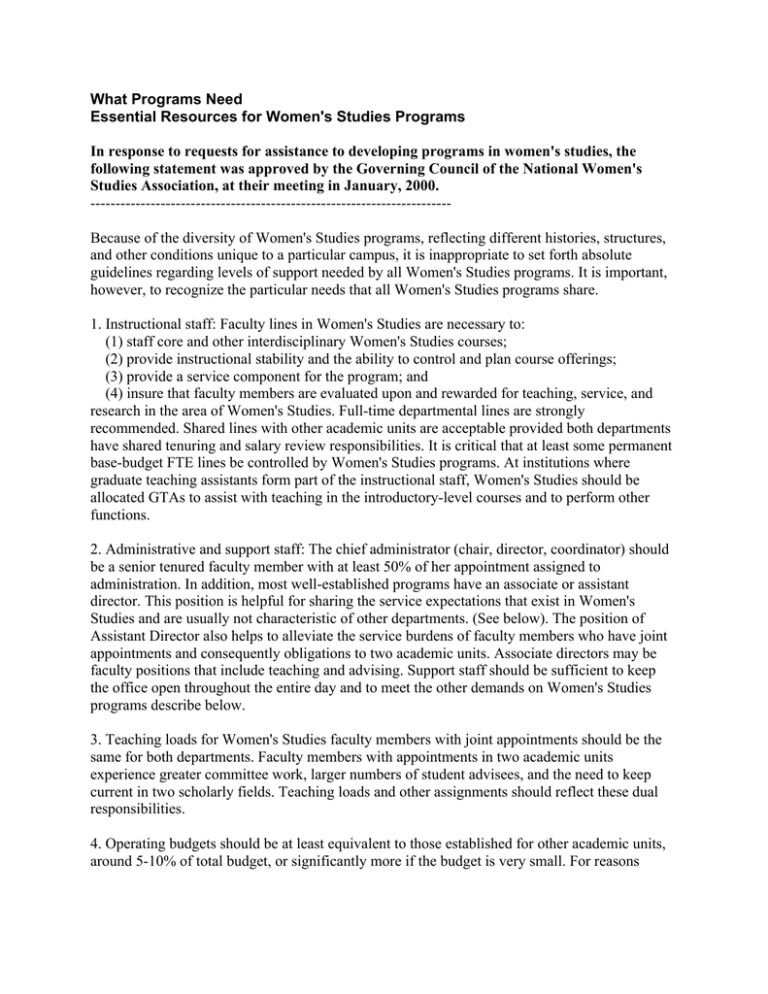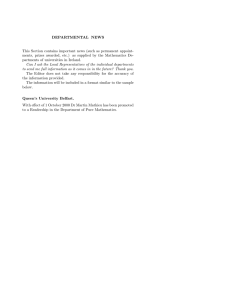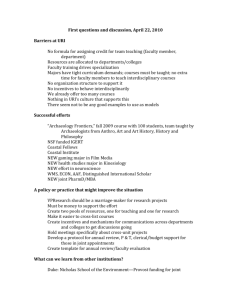What Programs Need Essential Resources for Women's Studies Programs
advertisement

What Programs Need Essential Resources for Women's Studies Programs In response to requests for assistance to developing programs in women's studies, the following statement was approved by the Governing Council of the National Women's Studies Association, at their meeting in January, 2000. -----------------------------------------------------------------------Because of the diversity of Women's Studies programs, reflecting different histories, structures, and other conditions unique to a particular campus, it is inappropriate to set forth absolute guidelines regarding levels of support needed by all Women's Studies programs. It is important, however, to recognize the particular needs that all Women's Studies programs share. 1. Instructional staff: Faculty lines in Women's Studies are necessary to: (1) staff core and other interdisciplinary Women's Studies courses; (2) provide instructional stability and the ability to control and plan course offerings; (3) provide a service component for the program; and (4) insure that faculty members are evaluated upon and rewarded for teaching, service, and research in the area of Women's Studies. Full-time departmental lines are strongly recommended. Shared lines with other academic units are acceptable provided both departments have shared tenuring and salary review responsibilities. It is critical that at least some permanent base-budget FTE lines be controlled by Women's Studies programs. At institutions where graduate teaching assistants form part of the instructional staff, Women's Studies should be allocated GTAs to assist with teaching in the introductory-level courses and to perform other functions. 2. Administrative and support staff: The chief administrator (chair, director, coordinator) should be a senior tenured faculty member with at least 50% of her appointment assigned to administration. In addition, most well-established programs have an associate or assistant director. This position is helpful for sharing the service expectations that exist in Women's Studies and are usually not characteristic of other departments. (See below). The position of Assistant Director also helps to alleviate the service burdens of faculty members who have joint appointments and consequently obligations to two academic units. Associate directors may be faculty positions that include teaching and advising. Support staff should be sufficient to keep the office open throughout the entire day and to meet the other demands on Women's Studies programs describe below. 3. Teaching loads for Women's Studies faculty members with joint appointments should be the same for both departments. Faculty members with appointments in two academic units experience greater committee work, larger numbers of student advisees, and the need to keep current in two scholarly fields. Teaching loads and other assignments should reflect these dual responsibilities. 4. Operating budgets should be at least equivalent to those established for other academic units, around 5-10% of total budget, or significantly more if the budget is very small. For reasons outlined below, Women's Studies program usually incur expenses for such items as postage, programming, and travel that exceed those of more traditional units. 5. Space: In Women's Studies programs where faculty have joint appointments, the faculty members usually have offices in their home departments. In order to foster within the Women's Studies program intellectual exchange, collegiality, identification with the Women's Studies office by Women's Studies faculty, offices within Women's Studies should be a high priority. Characteristics of Women's Studies programs that increase the need for resources: 1. Women's Studies programs usually form the focal point for teaching and research on women throughout the University. Therefore, programs need sufficient support staff and operating budgets to handle phone calls and written communication with faculty and departments across campus. Also, other academic units routinely call upon Women's Studies programs to co-sponsor guest speakers and other events, and operating budgets need to reflect these costs. 2. Women's Studies programs need resources to sponsor lectures and colloquia in areas of knowledge not well know to most faculty around the University. Such programs are also important in presenting speakers from minority groups which may not be adequately represented among existing faculty. 3. Faculty members in Women's Studies experience service obligations that are heavier than normal. Women's Studies faculty are called upon to provide expertise for many other academic units, especially when the campus is undergoing curriculum integration/mainstreaming. They are also asked to help other units recruit female faculty members. Further, those with joint appointments need to advise students, attend meetings, and serve on committees in two academic units. 4. Women's Studies programs need travel budgets sufficient to provide for the need of most of their faculty members to attend two sets of professional meetings, those in Women's Studies and those in the faculty member's other disciplinary area. 5. Women's Studies programs receive an unusually high number of requests for information. Representatives of the media and other individuals from the campus community and outside telephone or drop in with requests for advice or information about virtually anything having to do with women. Frequent calls come in from the media, women's organizations, businesses, and government agencies for expertise on issues concerning women. Women's Studies form an important link between the University and the community, but they need resources in the form of staff time, postage, newsletter expenses, and the like, in order to do this effectively. 6. Principles of feminist pedagogy encourage students to take more initiative in and responsibility for the learning process. Therefore, pedagogy calls for more involvement from both faculty and students, which in practice means a commitment to smaller classes and lower faculty/student ratios. 7. As increasing numbers of universities adopt general education curricula that require courses focusing on diversity, Women's Studies courses will experience increased enrollment demands. They are likely to receive pressure to convert to large lecture-based class formats, away from discussion-based courses that emphasize the development of critical thinking and writing skills. Women's Studies programs will need adequate resources to maintain their excellence in undergraduate teaching while meeting increased enrollment demands. -----------------------------------------------------------------------This statement is a modification of a statement written by Susan M. Hartmann for Women's Studies directors at Big Ten Universities, November 1991. It was revised by Dorothy C. Miller and Magdalena Garcia-Pinto for NWSA in 2001. ------------------------------------------------------------------------

